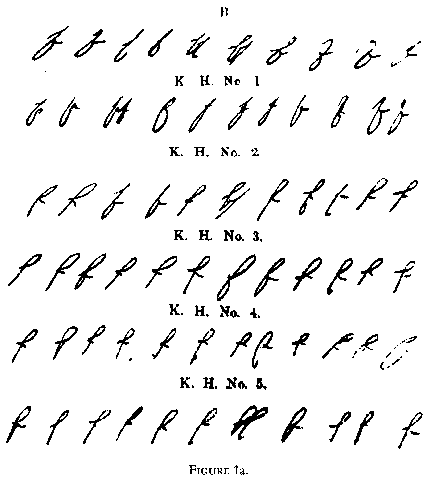
Editorial Note to Vernon Harrison's article "J'Accuse" (1):
In December 1885, The Society for Psychical Research [SPR] published in its Proceedings (Part IX, pp. 201-400) the "Report of the Committee appointed to Investigate Phenomena Connected with the Theosophical Society." The Committee consisted of: E. Gurney, F. W. H. Myers, F. Podmore, H. Sidgwick, J. H. Stack, R. Hodgson and Mrs. H. Sidgwick. The main bulk of this publication was the account written by Richard Hodgson who, at the behest of the Society, had gone to India to investigate further the activities of Mme. Helena Petrovna Blavatsky, co-founder with Col. H. S. Olcott, in 1875, of the Theosophical Society. Mme. Blavatsky was credited with a variety of paranormal phenomena but the Committee, in their Conclusions, accuse her of gross fraud and of being an impostor. Although, as it has been repeatedly pointed out, The SPR holds no corporate opinions, it has widely been regarded as responsible for endorsing the "Hodgson Report" (as we shall hereafter refer to the report as a whole) and hence as being on record as condemning Mme. Blavatsky. Members of the Theosophical Society have, naturally, resented this slur on the good name of their founder and have repeatedly challenged the Report's conclusions. For many years, Walter A. Carrithers, not a member of the Theosophical Society but a long-standing member of the SPR who has written extensively on the case, some of which is published under the pen name "Adlai Waterman," has campaigned to get the SPR Council to disown, publicly, the Report. In April 1983, Mr. Leslie Price, a member of the SPR Library Committee and, since January 1985, editor of the new quarterly Theosophical History, gave one of the SPR Lectures with the title: "Madame Blavatsky Unveiled?" (which is to be published early in 1986 by the Theosophical History Centre) in which he, too, criticizes Hodgson's methods and arguments. In this issue of our Journal, coming as it does almost exactly one hundred years after the publication of the Hodgson Report, we are happy, in the interests of truth and fair play, and to make amends for whatever offense we may have given, to publish here one such critical analysis by a handwriting expert. His expertise is of special relevance in this instance since much of the Hodgson Report concerns the authorship of certain letters which Hodgson claims were forged by Mme. Blavatsky herself. Dr. Vernon Harrison, a past President of the Royal Photographic Society, was, for ten years, Research Manager to Thomas De La Rue, printers of banknotes, passports and stamps, etc., so there is probably not much that he does not know about forgery. He is not a member of the Theosophical Society but he is a long-standing member of the SPR. Whether readers agree or disagree with his conclusions, we are pleased to offer him the hospitality of our columns and we hope that, hereafter, Theosophists, and, indeed, all who care for the reputation of Helena Petrovna Blavatsky, will look upon us in a more kindly light. — The Editor [John Beloff, Ph.D.]
The "Report of the Committee Appointed to Investigate Phenomena Connected with the Theosophical Society" (commonly called the Hodgson Report) is the most celebrated and controversial of all the reports published by the Society for Psychical Research. It passes judgment on Madame H. P. Blavatsky, the founder of Theosophy; and the final sentence in the "Statement and Conclusions of the Committee" has been quoted in book after book, encyclopedia after encyclopedia, without hint that it might be wrong. It runs:
For our own part, we regard her neither as the mouthpiece of hidden seers, nor as a mere vulgar adventuress; we think that she has achieved a title to permanent remembrance as one of the most accomplished, ingenious, and interesting impostors in history.— p. 207
For years Hodgson has been presented as an example of a perfect psychical researcher, and his report a model of what a report on psychical research should be.
I shall show that, on the contrary, the Hodgson Report is a highly partisan document forfeiting all claim to scientific impartiality. It is the address of a Counsel for the Prosecution who does not hesitate to select evidence to suit his case, ignoring and suppressing everything that tends to contradict his thesis. The Counsel for the Defense was never heard.
I make no attempt in this paper to prove that Madame Blavatsky was guiltless of charges preferred against her. At this distance of time, when all witnesses are dead and much of the evidence has been lost or destroyed, this would be difficult if not impossible. Nor do I attempt to establish the authorship or appraise the content of the Mahatma Letters. To do so is a fascinating but formidably difficult task. My present objective is a more limited one: to demonstrate that the case against Madame Blavatsky in the Hodgson Report is NOT PROVEN — in the Scots sense.
Madame Blavatsky's brush with the psychical researchers started with the Coulomb affair. This has been described many times from various points of view, and I need but outline events here. It seems that HPB and Madame Coulomb first met in Cairo about 1871. The Coulombs became bankrupt, had to leave, and turned up at Bombay in 1880, penniless and homeless, appealing to HPB for help. She gave them home and shelter, and positions of trust. Madame Coulomb became housekeeper and her husband acted as general factotum.
On 20 February 1884, HPB and Colonel Olcott left for Europe, entrusting the management of the Theosophical Society to a Board of Control. In March, the Board of Control found the Coulombs guilty of gross misconduct. They were dismissed on 14 May.
We next hear of them in the Madras Christian College Magazine. Selections of letters were published which, if genuine and interpreted correctly, would prove conspiracy in trickery between Madame Blavatsky and the Coulombs. HPB claimed that the letters were, at least in part, forgeries. In addition to these, a forged letter purporting to be written by Dr. Hartmann to Madame Coulomb, dated 28 April 1884, is asserted by Colonel Olcott to have reached him some weeks later in an envelope addressed in an unknown hand and bearing the Madras postmark, but the forger is not known.
While he was in England, Colonel Olcott made friendly contact with leading members of the Society for Psychical Research who were interested in reports of phenomena produced by HPB, and in May of 1884 the Council of the SPR appointed a committee to examine the evidence for the alleged phenomena. The members of this committee were: E. Gurney, F. W. H. Myers, F. Podmore, Henry Sidgwick, and J. H. Stack — with the later addition of Mrs. Sidgwick and R. Hodgson. The committee was able to examine Madame Blavatsky, Colonel Olcott, Mohini M. Chatterji and Mr. Sinnett. The result of their inquiries was published in First Report of the Committee, issued in 1884 for the private information of members of the SPR only. I have no quarrel with this report. It seems that the examination was carried out courteously and at the end the committee did not know what to think. The phenomena described seemed to be so remarkable and outside ordinary experience that they could be received only with strong reservations; on the other hand, the number of witnesses and the strength of the testimony were such that the evidence could not be dismissed lightly. They decided that there was a good case for further investigation.
This further investigation was made by Richard Hodgson during a three-months' visit to India. The final Report of the Committee, issued in Proceedings, Part IX, December 1885, is virtually Hodgson's report, since the rest of the committee did little more than rubber-stamp his conclusions. They made no attempt to correct glaring errors of procedure or to check critically Hodgson's findings.
The Blavatsky-Coulomb letters published by the Christian College Magazine are of prime importance since, if they are genuine and if they can be taken at their face value, they prove that HPB was engaged in fraudulent activities; and we need go no further. There seem to be only two possibilities:
(a) that HPB was engaged in fraud on a gigantic scale, involving a number of confederates, and was denounced by the Coulombs in disgust;
(b) that the Coulombs forged the incriminating letters in order to bring about HPB's downfall.
In considering these alternatives, one must take into account the possible motives of the participants.
If HPB was engaged in fraud on a vast scale involving many confederates, then even Hodgson had to admit that none of the usual motives for fraud applied. The best that he could suggest was that she was a Russian agent set to "foster and foment as widely as possible among the natives a disaffection towards British rule." In the 1980s when Russian agents are two a penny, this idea does not pull: there are more effective ways of promoting Russian interests in Afghanistan than by writing Isis Unveiled or forging the Mahatma Letters.
On the other hand, if the Coulombs forged the letters, their motive is clear: the primitive and powerful one of revenge. Having been dismissed under a cloud, they had lost both home and employment.
The point I stress is that, if Madame Blavatsky was suspect, so also were the Coulombs. Correct procedure requires that the incriminating portions of the Blavatsky-Coulomb letters should be reproduced in the report together with acknowledged specimens of the handwriting of Madame Blavatsky, Mr. Coulomb, and Madame Coulomb. This was never done; and it is omission inexcusable. We should also note that Madame Coulomb was, in modern terminology, a "supergrass" (2); and the testimony of such should be received with caution.
It is now morally certain that the originals of the incriminating Blavatsky-Coulomb letters have been destroyed. They are not in the archives of the Christian College at Madras, nor are they in the archives of the Theosophical Society at Adyar. I am much indebted to Anita Atkins of New York for the following information:
The last known recipient of the HPB-Coulomb letters was Professor Elliott Coues, Smithsonian scientist, and ex-theosophist, who turned against HPB, and gave a ferociously slanderous 7 column interview on her in the New York Sun in 1890. HPB sued for libel; the Sun's investigation and that of its lawyers found HPB had been slandered, and were about to award her damages, when she died. This under New York libel law ended the suit. But the Sun nevertheless publicly and editorially retracted.
During this period when Coues was fighting the suit, he bought the Coulomb letters, through an agent of the Scottish missionaries in India. I have a photostatic copy of his check. It is contained in the Coues archives at the State Historical Society of Wisconsin, Madison, Wisconsin. I have a microfilm of all his papers on theosophy and related matters. The Coulomb letters are NOT in the archives. Now Coues' purpose in acquiring the letters was to obtain evidence for his defense of HPB's suit, to prove her a fraud. His wife was a millionairess, and consequently he had every professional means available to overthrow HPB, if these letters were genuine.
However, complete silence — he never mentioned he had them. He either destroyed them during his life, or left instructions for his heir to destroy them.
Walter A. Carrithers has this to add:
About 1948 I procured a copy of the last Will of Professor Coues, and proceeded to search out his living posterity — only to learn that one of them, then but recently deceased, had pitched into his fireplace what was described as "many letters" ostensibly written by the hand of Madame Blavatsky; and, of all places, his residence had been just a way upstate from Fresno (so that I could have visited him on any day and determined what these were before their destruction!) in Palo Alto, California.
The circumstantial evidence that the Blavatsky-Coulomb letters were found after expert examination to be forgeries is strong.
No facsimile of any of the incriminating letters is given in the Hodgson Report. Hodgson explains that he had sent a selection (to wit, his selection) of the letters to F. G. Netherclift for a professional opinion, but found on his return to England that the letters had already been sent back to Madras, so that he could not make facsimiles of them. This is an unacceptable excuse. The letters were a vital part of the evidence. Photography was well advanced in 1884. There were good professional photographers operating in the Madras area who would have made accurate and permanent copies of these important documents. The handwriting of the Coulombs was never examined by Netherclift or by any other competent person.
Hodgson treats the whole matter very lightly and says:
I do not propose to go into any detail in describing the similarities between Madame Blavatsky's undoubted handwriting and the handwriting of the Blavatsky-Coulomb letters. These letters, before publication in the Christian College Magazine, were, as I have said, submitted by the editor to several gentlemen with experience in handwriting, who were unequivocally of opinion that they were written by Madame Blavatsky. The same opinion was also expressed by Mr. J. D. B. Gribble, of Madras, in "A Report of an Examination into the Blavatsky Correspondence, published in the Christian College Magazine." But the most important judgment on this point is that of the expert on handwriting, Mr. F. G. Netherclift, who has no doubt whatever that the disputed letters which were submitted to him were written by Madame Blavatsky. His report will be found on p. 381. Mr. Sims, of the British Museum, is also of the same opinion.
Under these circumstances I need say little more than that I examined the whole of these documents, and throughout I found those characteristics of Madame Blavatsky's handwriting which were present in the document I used as my chief standard, viz., a letter from Madame Blavatsky to Dr. Hartmann, written from Elberfeld in October, 1884.— pp. 276-7
To this I have to reply:
(a) The reported opinions of certain unnamed gentlemen are not evidence. Gribble tells us that the said gentlemen had experience in banking, not handwriting. No professional expert was available.
(b) We shall see later that Hodgson rejects Gribble's testimony in toto when it suits him. He cannot have it both ways.
(c) We have not a single written statement from Mr. Sims of the British Museum, only Hodgson's reports of what he said or thought.
It follows that the only independent testimony of any weight that we have is Netherclift's Report, reproduced (in part) on pages 381 and 382 of the Hodgson Report.
Mr. Sims of the British Museum is a shadowy figure who seems to do little more than echo the changeable opinions of Netherclift. I am grateful for the following information about him provided by the Archivist of the British Museum.
Mr. Richard Sims was the son of one of the senior servants at Wadham College, Oxford, and was educated at New College School (not New College itself). He joined the established staff of the British Museum in 1841 and resigned from the staff in 1887. He was proficient in Latin, Greek, French, and English, and had some knowledge of Spanish and German. He could read ancient writings with facility. He was appointed in the Department of Manuscripts as a Transcriber and became Assistant (First Class) in 1879. In a testimonial to his abilities, E. A. Bond, Keeper of Manuscripts at the Museum, stated that he was able to describe Charters and ordinary manuscripts in French and Latin, and that he could be serviceably employed in cataloguing charters and certain classes of manuscripts, such as those of Topography, Genealogy, and Heraldry.
There is thus no reason to doubt Sims' competence and integrity; but he was not a specialist in forgeries, and the fact remains that we have no direct written statements from him. We do not know whether his opinions were given verbally or in writing, and what exactly was asked of him. There is little prospect now that we shall ever locate his original letters or reports.
Netherclift's Report is a curious document in several respects.
(a) The title appended to it runs: "Report of Mr. F. G. Netherclift, Expert in Handwriting, on the Blavatsky-Coulomb Documents." This is misleading, for Netherclift was sent only a selection — Hodgson's own selection — of these documents. The Report itself is mutilated, part being excised; and it carries two dates.
(b) Netherclift starts his report: "In compliance with your instructions, I have carefully examined . . ." We are not told what these instructions were. Was Netherclift instructed to look for skillful fraudulent alterations to, or interpolations in, otherwise genuine letters? Or did he make a cursory inspection of the documents as a whole? We do not know.
Netherclift merely makes an ex cathedra pronouncement that the letters (whatever they may have been) were all written by Madame Blavatsky. What he should have demonstrated, giving his detailed reasons, was that the incriminating portions of the letters were in the genuine handwriting of Madame Blavatsky. No reference is made to any incriminating portions.
(c) Worst of all, the documents submitted to Netherclift cannot be identified. This is remarkable, since an Examiner needs, in his own interest, to state what his instructions were and to identify clearly the documents submitted to him for examination. This statement should form an integral part of the report — lest an unscrupulous client use the report to cover documents that have not been examined, with possible legal trouble later on.
Netherclift states that he had received two packets. With the exception of a slip of paper with writing commencing "Damodar send me," all the letters in PACKET 2 were sent to Mr. Myers and are not in dispute.
PACKET 1 is stated by Netherclift to have contained the following:
(a) Envelope marked 3 containing a slip of paper, the writing on which commences, "The Mahatma has heard . . ."
(b) A telegram in a different handwriting.
(c) An envelope addressed to Madame E. Coulomb.
(d) A letter on green paper.
(e) A letter on pink paper.
(f) Envelope marked 7 containing a scrap of ruled paper marked 10, the writing on which commences, "La poste . . ."
(g) Envelope directed [to] Madame and Monsieur Coulomb.
(h) Envelope marked 10 containing a letter marked 2, the writing on which commences, "Ma belle chere amie . . ."
(i) Envelope marked 28 containing a letter of several pages written in violet ink.
(j) Envelope marked No. 11 containing a letter in violet ink commencing, "Ma chere Madame Coulomb . . ."
The envelopes in PACKET 1 could have contained anything and are useless as evidence. The telegram, whatever it was, was not in Madame Blavatsky's handwriting. On pages 211-216 of the Hodgson Report, Hodgson gives fourteen extracts from the Blavatsky-Coulomb correspondence. Nine of these extracts carry an asterisk, which we are told means that "the letters from which these extracts are taken were among those examined by Mr. Netherclift." It is however impossible to relate them to the documents listed in Netherclift's PACKET 1.
The slip of paper starting, "The Mahatma has heard . . ." can be identified, and the text is not incriminating. We do not know what the letters on green and pink paper were nor, for that matter, to whom they were addressed.
Item (f), the slip of paper with the words starting, "La poste . . ." seems to be Hodgson's extract 12, which runs:
La poste part ma chere. Je n'ai qu'un instant. Votre lettre arrivee trop tard. Oui, laissez Srinavas Rao se prosterner devant le shrine et s'il demande ou non, je vous supplie lui faire passer cette reponse par K.H. car il s'y attend; je sais ce qu'il veut. Demain vous aurez une grande lettre! Grandes nouvelles! Merci. H.P.B.— p. 215
This chit seems to contain nothing more sinister than a hasty instruction to Madame Coulomb to allow Mr. Sreenevas Rao to pay his respects to the "shrine" and to make sure that he gets the enclosed letter from KH which he is expecting. Nothing miraculous is suggested.
Item (h) cannot be related to any of the starred extracts: none of them starts, "Ma belle chere amie . . ." Item (i) cannot be positively identified, but it may be the one dated 1 April 1884 which Gribble had noted as "by far the longest of any published" and which was written in purple, or violet, ink. If so, it was "partly defiant and partly imploring," but it contained no admission of guilt. Item (j) cannot be identified.
If we reject the envelopes and telegram in PACKET 1, we are left with two scraps of paper and five letters. Thus two, at least, of the starred extracts remain unaccounted for. These presumably were included in a completely unspecified "second batch of Blavatsky-Coulomb letters" submitted "shortly afterwards" to Mr. Netherclift. The documents sent in this "second batch" are not listed, nor have we any formal report on them; all we have is Hodgson's assertion that Netherclift returned them with a blanket endorsement on the cover in which they had been sent. Such laxity on the part of a professional expert is hard to credit, since letters could be removed from, or inserted into, this cover at any time without fear of detection.
We note also that of all the documents included in PACKET 1, five certainly, and possibly a sixth, were not incriminating. We are entitled to wonder therefore whether Netherclift examined any of the incriminating passages which might have been interpolated into otherwise genuine letters. We must also ask why his procedure was so lax and irregular.
The Mahatma Letters are attributed to more than one author. Hodgson confines his attention to the most important series of letters — the "Koot Hoomi" or "KH" scripts — and claims that he has established from his examination, confirmed by experts in handwriting, that HPB wrote the Mahatma Letters except those which he admits she could not possibly have written. These latter, he asserts, were written by confederates.
Two general points need first to be made. The first is that we have no right to assume that because a letter is signed "K.H." it is necessarily written by KH. The use by a busy man of a secretary was, and still is, common practice. Sinnett and others stated expressly that KH frequently dictated his letters to pupils; and if these pupils learned English script from their master, a common similarity of outline is not surprising. (3) The KH scripts preserved in the British Library are written in several very similar but nevertheless distinct hands. (4)
Secondly, in examining suspect letters or signatures, one does not pay much attention to the general outlines, since one can take it for granted that, unless a forgery is very crude, the outlines will be followed sufficiently well to be deceptive. It is the small unconscious mannerisms that are telling. Precisely because they are unconscious, they tend to persist for many years or even a lifetime; and they are difficult to eradicate. The fluency of the writing, and the variations in pressure that occur as the outlines are executed, can be all-important. (5)
In the best of photocopies or photographic prints, much essential detail is lost from the original. All the stereoscopic detail goes; and some of the fine detail is confused or left unrecorded. Tonal values are distorted. (6)
The Hodgson Report includes two Plates which appear at first sight to be photographs of handwriting. It is important to realize that they are not. The groups of letters in Plate 1, which play a major part in Hodgson's argument, are (I quote) "copied from tracings of my own made from the original documents, and hence many of them exhibit a tremulous appearance which is not characteristic of the original MSS, and which might have been avoided if the work had been done entirely by the lithographic artist" (Hodgson Report, page 284). They are thus copies of copies. I find it hard to see the reason for this, since photography was well advanced in 1884 and photolithography from zinc plates had been in use for two decades. The reference to "lithographic artist" implies that the copies were drawn by hand directly on the plates by an artist who observed the material to be copied in a mirror and who used a pen charged with greasy ink — as was done in the early days of lithography. Mrs. Sidgwick in her Appendix XV (page 379) says: "The plates representing short passages from different documents give a good general idea of the writing, but in some instances fail in giving the individual character of particular letters. Still they are quite sufficiently accurate to help the reader to understand the discussion. Those copied from writing in blue pencil are, as might be expected, less close facsimiles than the others."
We have only assurances from Hodgson and Mrs. Sidgwick that the plates are good representations of the originals and we cannot gauge how much distortion has been introduced during the process of copying. These Plates, however, are the only positive evidence that Hodgson adduces. He devotes many pages to a description of what he has found during his examination of documents while in India and elsewhere, but we have only his word for it.
I next examine the extraordinary behavior of Hodgson and the handwriting experts. I start with Mr. J. D. B. Gribble of Madras. In his "Report of an Examination into the Blavatsky Correspondence, published in the Christian College Magazine" (Higginbotham & Co., Madras, 1884), pages 7-9, he describes the forged Hartmann letter in the following terms:
The handwriting of this letter bears only a very faint resemblance to that of Dr. Hartmann. The letters are written in an up-and-down style, and are by no means dissimilar to those of the anonymous and pseudonymous letters which one so frequently receives in this country. In fact, the difference between the handwriting of this document and that of Dr. Hartmann is so striking that one of two suppositions is at once forced upon the mind:—
(1) Either the person who wrote this letter had never seen, or had no opportunity of copying, Dr. Hartmann's handwriting;
(2) or else the person writing it intended that the receiver should at once detect the forgery.
The only instance in which any resemblance to Dr. Hartmann's writing is to be found is in the formation of the capital H. This, however, is very laboured and very forced.
Gribble states that he has examined this letter very carefully, and adds:
That the Hartmann letter is so clumsy a forgery that its falseness would at once be apparent to any one who was acquainted with that gentleman's handwriting.
Thus Gribble. Hear now what Hodgson has to say about this selfsame letter:
The imitation of Dr. Hartmann's characteristics is for the most part exceedingly close, and on this point I must differ entirely from Mr. Gribble, who was evidently unfamiliar with Dr. Hartmann's writing; . . . . I should say that Mr. Gribble had the opportunity of examining the document only very hastily during a short visit of an hour at the headquarters of the Theosophical Society, when he examined other documents also; and this accounts for the mistakes which he made in his examination of it.
The contradiction here is absolute, and goes far beyond what one could reasonably attribute to faulty observation or general ineptitude. There is no way of reconciling the two statements. Had Hodgson given a facsimile of the Hartmann letter, we might have been able to decide whose description was correct; but no facsimile is given.
Netherclift and Sims were called upon to examine some of the KH documents. They both reached the conclusion that these documents were NOT written by Madame Blavatsky. This also was Gribble's opinion. Hodgson would have none of this, and says (page 282):
I had already expressed my own conclusion, reached after an investigation of K.H. writings in India, that those I had examined were, with the exception of the K.H.(Y), written by Madame Blavatsky, and on my arrival in England I was surprised to find that Mr. Netherclift was of a different opinion concerning the K.H. writings submitted to him.
The final report was held up while more specimens were obtained, and (I quote):
The result was that Mr. Netherclift came to the conclusion that the whole of these documents were without doubt written by Madame Blavatsky.
Mr. Sims of the British Museum changed his opinion to suit.
I find that the most revealing passage comes from Hodgson's own account (pages 296-7):
My own view is that Mr. Damodar unquestionably wrote the K.H.(Z) as well as the K.H.(Y). Mr. Netherclift has had no opportunity of seeing the K.H.(Y), which was only lent to me for a short time in India, but the K.H.(Z) was submitted to him with the other K.H. documents upon which he was asked to give a second opinion, with the additional light afforded by those lent to us by Mr. Sinnett. Mr. Netherclift, in his second report, stated as his opinion that it was "quite impossible that Damodar could have accommodated his usual style to suit that of K.H.," . . . I then submitted to him my analysis of the document, and he kindly undertook to make a further examination, expressing his confidence that he would prove to me that the conclusion which I had reached was erroneous. The result, however, of a prolonged comparison which he then made was that he frankly confessed that my view was the correct one, saying that in the whole course of his many years' experience as an expert, he had "never met a more puzzling case," but that he was at last "thoroughly convinced that" the K.H.(Z) "was written by Damodar in close imitation of the style adopted by Madame Blavatsky in the K.H. papers."— pp. 296-7
Speaking as a professional examiner of questioned documents who has on occasion to undergo cross-examination in Court, I do not claim to be infallible. I give an opinion, and the reasons for that opinion, backed up by photographic and micrographic evidence wherever applicable. For legal purposes an opinion once given must stand. If a client does not agree with my findings, he is at liberty to go elsewhere and get further opinions. What I am not prepared to countenance is to have my client openly seeking to influence my judgment and, in effect, dictating what my report should be. I find Hodgson's blatant, and successful, efforts to influence the judgment of his experts highly improper. No English Court would accept a report known to have been made in such circumstances.
I now go to the heart of Hodgson's argument. He makes three cardinal statements (p. 283):
I. That there are clear signs of development in the K.H. writing, various strong resemblances to Madame Blavatsky's ordinary handwriting having been gradually eliminated.
II. That special forms of letters proper to Madame Blavatsky's ordinary writing, and not proper to the K.H. writing, occasionally appear in the latter.
III. That there are certain very marked peculiarities of Madame Blavatsky's ordinary writing which occur throughout the K.H. writing.
I concentrate on the first and third, since, if these are wrong, the second has no importance.
Hodgson bases his thesis mainly on a series of KH letters lent by Mr. Sinnett, and he remarks:
Facsimiles of the series of K.H. letters lent by Mr. Sinnett would perhaps have been interesting and suggestive to the reader(7), and would have clearly shown the development of the K.H. hand; but Mr. Sinnett strongly emphasized his desire that no use whatever should be made of the specimens he submitted except for comparison of handwriting, and the facsimile production of portions of the documents was, of course, impossible without the publication, to some extent, of their substance. I have therefore chosen several small letters, f, g, k and y, for the purpose of illustrating the development I have mentioned.-- pp. 283-4
To this I retort that it is easily possible to photograph portions of a document to show the characteristics of handwriting without revealing anything of the document's contents, and it is interesting to speculate why Hodgson did not do so.
Figures 1a and 1b are reproduced photographically from the Hodgson Report and show the development claimed for the f and g. Similar series are given by Hodgson for the letters k and y, but here the development is less striking.
Figure 1a: 
Figure 1b: 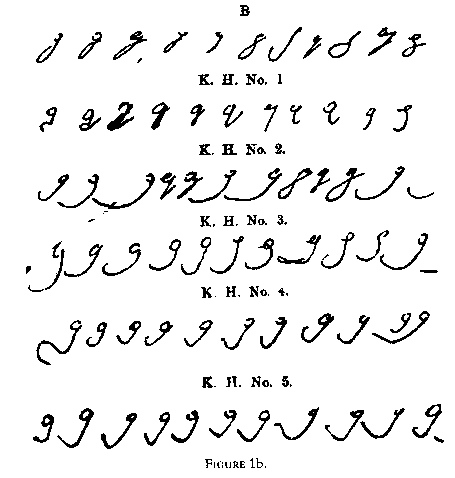
Hodgson points out that HPB's ordinary f's are commonly looped only below, and are usually preceded by an up stroke. The developed KH forms are looped only above. K.H. No. 1 and K.H. No. 2 show intermediate forms. Similar remarks apply to the g's. This is the only verifiable evidence that Hodgson adduces in support of his statement. We examine the series more closely.
The row marked "B" is taken from the undoubted writings of Madame Blavatsky. Mr. Sinnett describes the others as follows:
"No. 1 * * * is the first sheet of the first letter I ever had from him certainly through another hand. (8)
"Nos. 2 and 3 are selections from later letters of the old series written before publication of `The Occult World.'
"No. 4 was received by me in London about the time `Esoteric Buddhism' was published.
"No. 5 * * is from a letter certainly in K.H.'s own handwriting."
We see therefore that Sinnett states explicitly that No. 1 is from KH but is not written by him. The date is about October 1880. The dates of Nos. 2 and 3 would be before June 1881. The date of No. 4 would be before June 1883. Sinnett affirms that No. 5 is in KH's own handwriting, but does not give the date.
This, forsooth, is a series selected for demonstrating the progressive development of the selfsame hand over a period of four years. We note that what Hodgson has shown us are isolated characters torn from their context. If we believe Sinnett, they are not all by the same writer. They are copies of copies. We do not know whether the letters selected are a fair sample taken from the manuscript or whether they have been specially selected to support Hodgson's case. We are told nothing of the other twenty-two letters of the alphabet.
What Hodgson does not mention is that his Plate 2 also covers a series of KH documents over the same period. The dates are:
K.H.(i) — 1 November 1880 (9)
K.H.(ii) to (vi) — 1881-1882
K.H.(vii) — 1884
We are thus entitled to expect that this series should show a similar development of style. It shows nothing of the sort. K.H.(i) is fully "developed" and Figure 2 reproduces part of it directly from the Hodgson Report.
Figure 2: 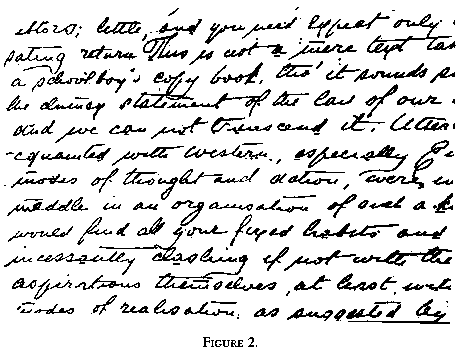
Eight f's are shown, all of which are looped above in a manner agreeing perfectly with K.H. No. 5 of Figure 1a. The same remarks apply to the g's.
Either Hodgson did not notice that the evidence in his Plate 2 flatly contradicts his argument, or he elected to ignore it, concentrating on examples carefully selected to support his case. So much for his impartiality.
Many of the KH letters are preserved in the British Library, and I find from examination of these that fully "developed" KH writing, conforming in every respect to later KH letters, was being received as early as 29 October 1880. Other letters were written in writing very similar to, but nevertheless distinct from, KH's writing; and these may have been written by scribes.
There is no evidence for the "development" in the KH writing that Hodgson claims.
I quote Hodgson:
The evidence which we are now to consider is, in my view, the most important of all in proof of the fact (10) that the K.H. writings in general are the handiwork of Madame Blavatsky. This evidence depends on Madame Blavatsky's formation of the group of letters a, d, g, o, and q. The peculiarities exhibited in these letters are very striking; they are sufficiently shown in the specimens of a, d, o, and q, which I have given in group B´´ (all the letters in which are taken from the undoubted writings of Madame Blavatsky), and are apparent also in the different groups of g's which I have given as manifesting the evolution of the characteristic K.H. g.
The group of B´´ letters is reproduced from Hodgson in Figure 3, and the g's are reproduced in line B of Figure 1b.
Figure 3: 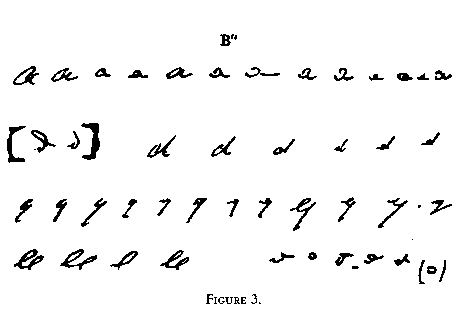
Hodgson continues:
A properly made "o" formation is uncommon both in Madame Blavatsky's ordinary handwriting and in the K.H. writings. If the letter requiring such a formation is initial, or not connected with the preceding letter, the tendency in both handwritings is to produce a formation akin to those shown in the first four a's, the first three English d's, and the first four q's. If the letter is connected with the preceding letter, the tendency is either to begin the "o" formation high up with a loop, as happens most commonly in the case of the d, leaving a gap above, — or to begin it low down, in which case the curve is rarely closed by a complete backward stroke, — and a peculiar gap therefore remains on the left-hand side. This last method of formation, which I shall call the left-gap stroke, may be clearly seen in some of the q's and o's, and is yet more noticeable in the g's and a's, of which last especially it is the common, conspicuous, and most highly characteristic feature, both in Madame Blavatsky's ordinary writing and in those K.H. writings which I attribute to her. It is so peculiar, that were it found but rarely in both sets of writings, or commonly in one and rarely in the other, it would still be a tolerably definite indication of identity of handiwork; but when we find, as we do, that it occurs constantly in both sets of writings, that any other form (except the initial forms spoken of) is comparatively rare, and that numerous varieties of the type in the one set of writings can be exactly paralleled in the other, there can, I think, be little doubt that one and the same person wielded the pen throughout.
Hodgson concludes the paragraph by saying:
It must be difficult for any person to trace this left-gap stroke throughout a series of Madame Blavatsky's acknowledged writings, and throughout a set of what I believe to be her K.H. writings, comparing in detail all the swirling tricks and fantastic freaks of curvature which it adopts, and at the same time resist the impression that the same person executed them all.
The points made are well shown in Figures 4a and 4b, which should be compared with Figure 3 and Figure 1b.
Figure 4a: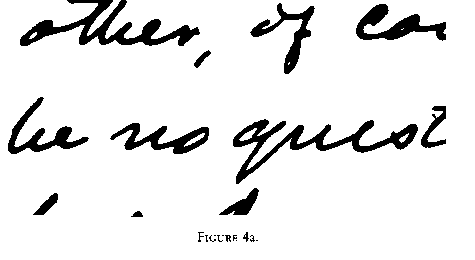
Figure 4b: 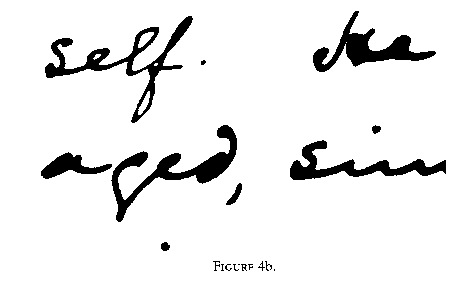
In Figure 4a, the o of "of" closely matches the o in the fourth line of Figure 3, fifth character from the left. It is followed by the typical Blavatskian f. The o in "other" can be seen in the fourth row, seventh character from the left, in the same Figure. The q in the second line of Figure 4a closely matches the q in Figure 3, third row, ninth character from the left. In the second line of Figure 4b, the word "aged" shows all the Blavatskian characteristics. The a can be found in Figure 3, row one, third character from the left. Madame Blavatsky makes a weird assortment of g's, but the one in Figure 4b is clearly intermediate between the sixth and eighth characters from the left in the top line of Figure 1b. The d matches the second character from the left in row two of Figure 3.
It happens that the fragments of writing represented in Figures 4a and 4b were written, not by Madame Blavatsky, but by MARK TWAIN; and this will surely demonstrate the futility of trying to draw valid conclusions from an examination of letters torn from their context. The piece of writing to which 4a and 4b belong is reproduced in Figure 5,
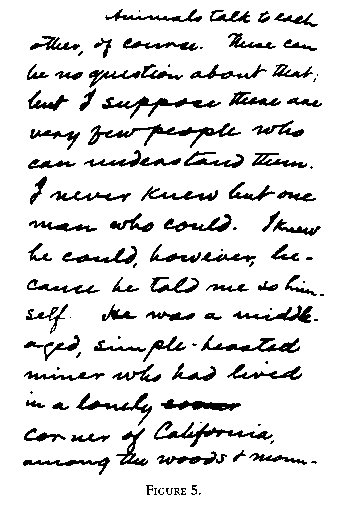
which is of interest because it shows that, like Madame Blavatsky, Mark Twain uses what Hodgson calls the German and English types of d indiscriminately. To be sure, Mark Twain's writing is not the same as HPB's, but it contains so many Blavatskian features that, using Hodgson's methods, one could prove that HPB wrote Huckleberry Finn.
Figures 6 and 7 reproduce two of the facsimiles of HPB's acknowledged writing given in Plate 1 of the Hodgson Report. Compare with them the writing shown in Figure 8.
Figure 6: 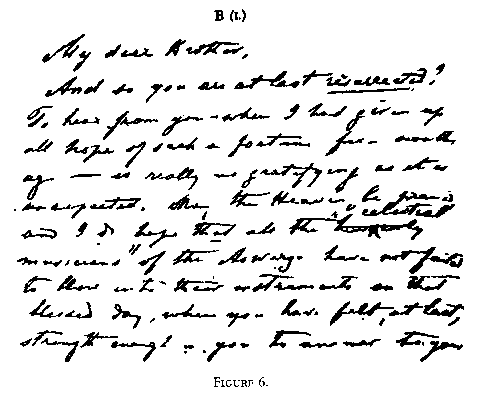
Figure 7: 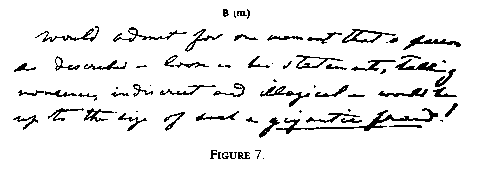
Figure 8: 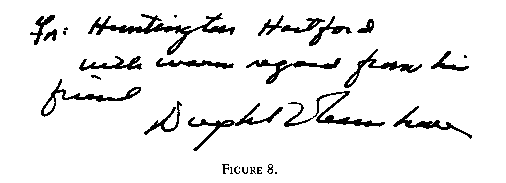
The slope is the same. The spacing is the same. The rhythm is the same. The formation of the important letters f, g, h, m, n, and t is, as near as may be, the same. The a of "regard" in line two of Figure 8 is a good specimen of Blavatskian left-gapping. However, the lines in Figure 8 were written, not by Madame Blavatsky, but by PRESIDENT EISENHOWER. The resemblance of his writing to HPB's is truly extraordinary. Through the courtesy of Ambassador John S. D. Eisenhower, I have been able to examine one of the late President's personal letters, written in the field about the close of World War II. Figure 9 shows a small enlarged portion. Note the beautiful examples of the left-gap stroke. Using Hodgson's methods, I could prove "without doubt" that The Secret Doctrine was written by Dwight D. Eisenhower.
Figure 9: 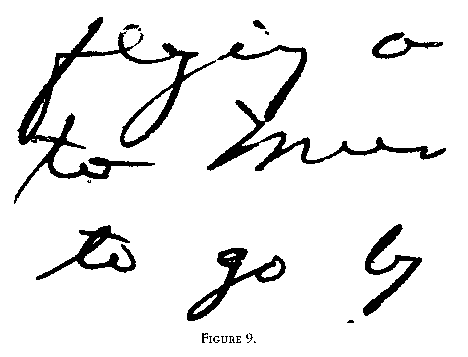
Finally, I am much obliged to Mr. Michael Gomes for a photocopy of the only letter he has come across from the Coulombs in the Theosophical Society archives at Adyar. It is from Mr. Coulomb, imploring HPB not to eject him from the Bungalow and saying that they can explain all when she arrives. Being on thin paper, the writing shows through to the reverse side; and both sides are recorded in the photocopy as shown in Figures 10a and 10b. Nevertheless, some of the writing is plain enough. Figure 10a starts:
Chere Madame
Ma femme vient d'arriver elle me porte un petit paragraphe qui vous concerne et moi en amitie je vous l'envoie elle me dit . . .
Figure 10a: 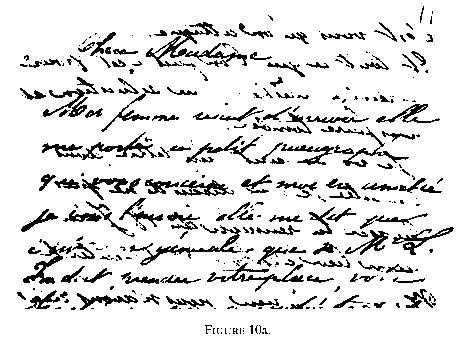
Figure 10b starts:
C'est vous qu'on attaque
Et tout ce que l'on fait c'est pour se rendre maitre de la situation et vous faire tomber . . .
Figure 10b: 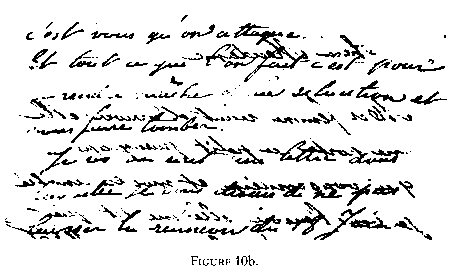
Note the remarkable left-gappery in the
q of "qui" on line 4 of Figure 10a
qu in line 1, Figure 10b, and
que in line 2 of Figure 10b
and compare with them the q's of Figure 3.
Note also the construction of the a's in
amitie in line 4 of Figure 10a
attaque in line 1 of Figure 10b, and
situation in line 3 of Figure 10b
and compare with them the a's of Figure 3.
These examples surely suffice to show that there is nothing uniquely characteristic about the letters represented in Figure 3 and the first line of Figure 1b. The presence of the left-gap stroke does not prove that the writer was H. P. Blavatsky.
Hodgson's Third Cardinal Statement is false.
What Figures 10a and 10b do show is that Coulomb, having close acquaintance with and access to HPB's writing, and also the initial advantage of having writing similar to hers in important respects, could have interpolated passages into her genuine letters without much difficulty. (11) Why did Hodgson not even consider this possibility? Why were no specimens of Mr. Coulomb's writing sent for independent examination?
Gribble, in his "Report," says that if Madame Blavatsky did not write the incriminating correspondence, the only other suspects are the Coulombs. (Granted; they had ample motive.) He states that Madame Coulomb's writing was quite unlike that of Madame Blavatsky. (This is as may be.) However, he goes on to dismiss Mr. Coulomb in the extraordinary statement:
Mr. Coulomb may at once be relieved from any suspicion. He is only imperfectly acquainted with English, and it would have been an impossibility for him to have written the letters.
One is constrained to ask, in the name of Heaven, why? Most of the incriminating passages were written, not in English, but in French — and bad French to boot. A forger has to have a keen eye and memory for outlines, and skill in controlling a pen; he does not have to compose the matter he is forging. Madame Coulomb could have done that for him.
It is hardly a surprise now to find that there are systematic differences between the writing in the KH scripts and HPB's acknowledged writing which Hodgson does not mention. I take three of the more important letters.
The "developed" KH scripts (which, as I have said, start as early as October 1880) show a remarkable formation of the letter p: the main down stroke and the return up stroke are widely separated, and the final loop is degenerate. Examples showing clearly what I mean will be found in Figure 2:
in line 1 — "expect"
in line 3 — "copy"
in line 6 — "especially," and
in line 11 — "aspirations."
With HPB, the main down stroke and the return up stroke usually overlap in the normal manner. Examples will be seen in
Figure 6, line 4 — "hope"
Figure 6, line 6 — "unexpected" and "praised"
Figure 6, line 7 — "hope"
Figure 7, line 1 — "person" and
Figure 7, line 4 — "up."
The difference is persistent and significant.
h. In the KH scripts the leading stroke and main down stroke of the letter h are made in a continuous movement, and the down stroke is concave to the right. The final "hump" is low and strongly skew to the right. Good examples are shown in
Figure 2, line 3 — "tho"
Figure 2, line 7 — "thought"
Figure 2, line 9 — "habits," and
Figure 2, line 10 — "clashing."
The h in HPB's writing has a down stroke that is either straight or slightly concave to the left, and the "hump" is much less skew. Examples are shown in
Figure 6, line 3 — "hear," "when," "had"
Figure 6, line 4 — "hope"
Figure 6, line 7 — "hope," "that"
Figure 6, line 8 — "have."
The difference is persistent and significant.
n and m. The initial n in the KH scripts is usually like the Greek letter "mu" with a long leading stroke. Examples are:
Figure 2, line 1 — "need"
Figure 2, line 5 — "not"
Figure 2, line 10 — "not."
Within a word there is little difference between n and u. The letter m exhibits the same peculiarities. Examples are:
Figure 2, line 2 — "mere"
Figure 2, line 7 — "modes"
Figure 2, line 8 — "meddle"
Figure 2, line 12 — "modes"
HPB's m's and n's follow a saw-tooth pattern, the up strokes being at roughly 30° and the down strokes at about 80° to the horizontal. Examples are shown in
Figure 6, line 8 — "musicians," "not"
Figure 7, line 1 — "moment"
Figure 7, line 3 — "nonsense"
The difference is persistent and significant.
I do not think it is necessary to proceed further. If HPB wrote the Mahatma Letters, she did not gradually perfect her style, as Hodgson maintains. She had to get it right, from the beginning. Every time she made an f, a g, an h, a p, an n, or an m, she had to remember to make the right outlines while maintaining fluency and avoiding any reversion to her normal style. The KH documents that I have examined in the British Library are fluent in their execution and show no sign of hesitancy. I can find no clear evidence that HPB wrote them and I find significant evidence that she did not. I do not know who wrote the Mahatma Letters, but I do not find it plausible to assume that Madame Blavatsky wrote them — the great bulk of them at any rate.
That is my professional Opinion.
The Mahatma Letters show several curious features. I am not saying that they are paranormal, but they at least excite interest. In general, the documents appear to be written either in black ink, or in blue or red pencil, on any piece of paper that happened to be available. I say, "appear to be written," because I would like laboratory confirmation that the black marks are composed of the writing ink of the period; and I would like to know the composition of the pencils — if pencils were used.
I take first those documents apparently written in colored pencil. On many, though not all, the writing is built up, not of normal pencil strokes, but of thin parallel lines, spaced at about forty to the inch and inclined at about thirty degrees to the horizontal. This goes on for page after page with the greatest regularity. The lines are sharply defined, and the spaces between them are either devoid of color, or are filled by a uniform pale blue or pink tint. When the spaces between the lines are clear, the writing looks as if it had been made with a modern ink-jet printer coupled to an electronic scanner. (12)
Something like this effect can be produced by writing with the paper supported on ribbed bookcloth; and Madame Coulomb affirmed that this is how the writing was done. Why one should want to use so uncomfortable a support for no apparent reason is not explained.
I have a large collection of artists' colored pencils in four different makes, besides Conte crayon, carbon, graphite and chinagraph pencils. I have experimented with a selection of these on various papers supported on ribbed covers of books taken from my library, and I cannot get the clean, sharp effect shown by many of the Mahatma pencil scripts. Signs of pencil drag, pencil debris between the lines, and irregularity of outline and line spacing are always apparent. This is not to say that the effect cannot be reproduced; it is to say that, so far, I have not been able to do so, despite some effort.
The documents that appear to be written in black ink are equally fascinating. The dark marks seem to be within the paper rather than on the surface. It is hard to be sure of this now, because the bound letters have been laminated in archival tissue in order to preserve them. One has therefore, to distinguish between the fibers of the protective tissue and the fibers of the paper of the letter itself.
What is certain is that corrections have been made to the text with great care, by erasing words or whole phrases, and writing the corrections over the erasure. These erasures have not been made by rubbing with a hard rubber or by scraping with a knife, for there is no local weakening of the paper. It seems that a chemical ink eradicator has been used; but application of liquid reagents usually disturbs the surface fibers of paper and leaves faint stains that are hard to eradicate. Signs of this are not obvious. It would be interesting to know from laboratory tests whether there are traces of chemical residues in the paper in these regions; if there are not, it may be that the corrections were made on originals of which the documents now preserved in the British Library are copies.
It is impossible to answer these questions under the conditions of the Reading Room, armed only with a pocket microscope. One can only hope that one day permission will be given for the necessary (nondestructive) laboratory work to be done.
I have concentrated on the handwriting aspect of the Hodgson Report, partly because it forms a major part of his thesis and I am here playing on my home ground, but more importantly because everything I have stated can be checked independently. We do not have to rely on the testimony of long-dead witnesses. The witness here — and an eloquent one — is the Hodgson Report itself.
As detailed examination of this Report proceeds, one becomes more and more aware that, whereas Hodgson was prepared to use any evidence, however trivial or questionable, to implicate HPB, he ignored all evidence that could be used in her favor. His report is riddled with slanted statements, conjecture advanced as fact or probable fact, uncorroborated testimony of unnamed witnesses, selection of evidence and downright falsity.
As an investigator, Hodgson is weighed in the balances and found wanting. His case against Madame H. P. Blavatsky is not proven.
I cannot exonerate the SPR committee from blame for publishing this thoroughly bad report. They seem to have done little more than rubber-stamp Hodgson's opinions; and no serious attempt was made to check his findings or even to read his report critically. If they had done so, its errors of procedure, its inconsistencies, its faulty reasoning and bias, its hostility towards the subject and its contempt for the "native" and other witnesses, would have become apparent; and the case would have been referred back for further study. Madame H. P. Blavatsky was the most important occultist ever to appear before the SPR for investigation; and never was opportunity so wasted.
Nor can I exonerate the quondam Council of the Theosophical Society for their failure to allow their founder fair defense. They seemed concerned only with saving their own reputations. Whether she was impostor or not, HPB was entitled to a fair hearing. She never had it. Had she been allowed the legal and expert help she begged for, both Hodgson and the Society for Psychical Research would have been in dire trouble.
It is a thing most wonderful that Hodgson was able so completely to bamboozle, not only Netherclift and Mr. Sims of the British Museum, but also men and women of the caliber of Myers, Gurney, and Mrs. Sidgwick — not to mention several generations of psychical researchers since the 1885 Report was published.
On 14 January 1886, Madame Blavatsky wrote:
That Mr. Hodgson's elaborate but misdirected inquiries, his affected precision, which spends infinite patience over trifles and is blind to facts of importance, his contradictory reasoning and his manifold incapacity to deal with such problems as those he endeavoured to solve, will be exposed by other writers in due course — I make no doubt. — H. P. Blavatsky: Collected Writings 7:9
I apologize to her that it has taken us one hundred years to demonstrate that she wrote truly.
1. "J'Accuse" — title of Emile Zola's celebrated open letter to the President of the French Republic concerning the Dreyfus case. (return to text)
2. ["Grass": British slang. An informer, esp. a police informer. "Supergrass": A member of a criminal gang who turns police informer on the others and expects concessions in return. — V.H.] (return to text)
3. William Blake taught his wife to write; and her writing is almost indistinguishable from his. (return to text)
4. [This was my view at the time of writing, but see Opinion (5), p. 67. — V.H.] (return to text)
5. [See Part 2, Methods of Examination. — V.H.] (return to text)
6. [Photocopies have much improved in quality during the past decade, but examination of the originals should always be made whenever possible. — V.H.] (return to text)
7. They would indeed. — V.H. (return to text)
8. [A photograph of the whole page is reproduced in Figure 12. — V.H.] (return to text)
9. [Referred to in detail in Part 2, p. 50. — V.H.] (return to text)
10. It was not a fact that the KH writings were the work of Madame Blavatsky; it was only Hodgson's hypothesis that this was so. — V.H. (return to text)
11. [See Part 2, p. 43, 2nd paragraph. — V.H.] (return to text)
12. [See Figure 11 in color plates. The extreme regularity of the striations may be checked by draftsmen's parallel rulers and a protractor. — V.H.] (return to text)